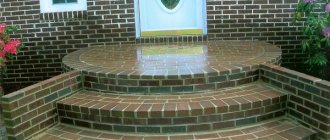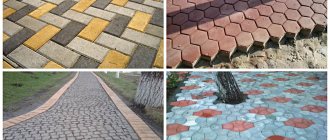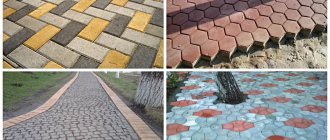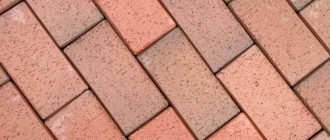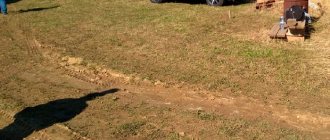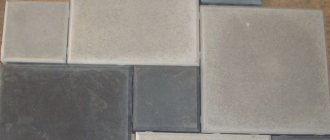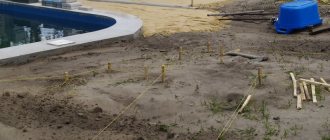Types of paving stones and their features
Paving stones are a reliable and beautiful covering for the sidewalk in the courtyard of a private house and beyond. There is a huge variety of paving slabs in shape, size, color and method of laying them . Options for laying paving slabs can be very diverse. Also, paving stones differ according to the material from which they are made. A creative approach to laying tiles in just two different shades will make your private yard unique and inimitable.
Paving nuances
Work usually begins from the lowest point of a particular site after breaking it with cords, taking into account the slopes for gravity removal of wastewater. Features of the technology are:
- rigid spatial box - without curbs or storm drainage trays, paving slabs will slide along the sides of paths/parking lots, so these are the elements that are installed on the mortar first;
A box of storm drainage trays on one side and curbs on the other edge of the path.
Separating layer under crushed stone.
Advice! FEM luminous elements located in a certain order or randomly scattered throughout the paving area will significantly increase the originality of the exterior and make walking at dusk easier.
Treating the surface of the facing material with special preparations that increase the moisture resistance of concrete immediately after paving will reduce operating costs. A white coating will not appear on the tiles, the facing material will not be destroyed by frozen water, and will receive an additional protective layer.
Stages of laying paving stones
Correct installation of the material simply transforms the surface - it becomes durable, neat and beautiful. But the slightest mistake can disrupt the composition, thereby distorting the desired design. That is why it is better to entrust the laying of paving stones to specialists who will develop a design project and monitor compliance with the technology at every stage.
1) Preparatory work.
Regardless of the chosen installation option, this stage must be carried out without fail.
2) Laying.
Includes several options:
- laying paving stones on a sand base;
- laying the material on a concrete base;
- laying on a crushed stone base with a dry mixture.
Paving nuances
It is recommended to start paving products with preparing the base. To do this, it is necessary to compact the subgrade to a state of stability, paying special attention to the organization of the drainage system. In case of high groundwater levels, the use of geosynthetic materials is required. A load-bearing layer is not laid on sandy soil. The transverse slope of the base must correspond to the location of the outer covering. Sand and fine crushed stone are used as underlying material. In areas designed for high loads, cement or lime is used as a binder layer to give strength to the base. When laying “Brick” tiles under canopies or surfaces protected from precipitation, a dry mixture is used. The seams between the tiles are filled with sand. All elements must be laid exactly in height, taking into account the angle of inclination and direction of the route.
To ensure that the seams are evenly positioned, the cord is pulled in the longitudinal direction. When laying on a large area, 2 control lines are placed and right angles are measured every 1-3 meters.
A curb stone is used as a boundary fence, which preserves the integrity of the canvas. Established standards allow an unevenness of 1 cm within 4 m of masonry. To ensure high-quality installation, the use of special equipment is required. FEM compaction is carried out using a vibration device.
After laying, the working surface is sprinkled with sand and left until the joints are filled. When paving pavements along which traffic moves with “Brick” paving stones, the seams must have a stable filling. The use of a durable material is necessary to evenly distribute the shear forces created by the wheel load.
Self-paving paving requires the preparation of tools, materials and equipment. When choosing a location for installation, you need to decide on water flow. On the marked area, the turf layer is removed and a cushion of crushed stone and sand is installed. FEMs are laid away from themselves in a diagonal direction. Unevenness of the base is adjusted with sand, which, if necessary, is removed or poured under the masonry elements.
Laying paving slabs brick in two colors
OUR TILES + LAYING = 20% DISCOUNT!
More than 100 models of tiles and paving stones to choose from. Any colors to order. GO TO CATALOG
Brick paving slab laying scheme
Uniform shift of elements:
Elements of brick structures:
Uneven shift of elements:
Geometric symmetry is divided into uniform and uneven shift of elements. In this way, it is possible to create both symmetrical and asymmetrical pavement patterns, with repeating frequency.
You can lay purchased paving slabs yourself, but it is not a fact that the result of your work will justify your hopes. Proper facing and laying of tiles is the key to the success and durability of the path.
There are a huge variety of options for laying rectangular paving slabs and there is always room for creativity. Each track will be individual in its own way.
Options for laying paving slabs bricks
Delivery of paving slabs from 1900 rubles! Only until the end of the month
I'm not kidding! Special prices apply for delivery of tiles and paving stones. Prices are indicated for order volumes up to 20 m2 . For delivery costs for larger quantities, please contact your manager by phone.
| Direction | Settlements | Price |
| Leningradskoe highway | Zelenograd, Khimki, etc. | 1900 rub. |
| Pyatnitskoe highway | Otradnoe, Firsanovka, etc. | |
| volokolamskoe highway | Krasnogorsk, Nakhabino, Dedovsk, Istra | |
| Novorizhskoe highway | Arkhangelskoye, Pavlovskaya Sloboda | |
| Ilinskoe highway | Zvenigorod | |
| Rublevskoe highway | Rublevo, Barvikha, Gorki | |
| Mozhaiskoe/Minskoe highway | Nemchinovka, Zarechye, Novoivanovskoye, Odintsovo, Krasnoznamensk | |
| Kyiv/Borovskoe highway | Moskovsky, Aprelevka, Kokoshkino |
You can always find out the full list of settlements participating in the promotion from the operator by phone.
Dimensions and installation details
Despite the name of the figured paving element and the external similarity with ordinary brick, the dimensions of paving slabs differ from it:
- standard dimensions – 20 x 10 cm, thickness 5 – 8 cm;
- non-standard size – height 7 cm, 18 x 8.8 cm, 21 x 7 cm or 24 x 16 cm.
Dimensions FEM Brick.
An additional element used in some Brick paving schemes is a Cube measuring 10 x 10 cm for standard FEM or 8.8 x 8.8 cm for non-standard products. On the long sides of the paving slabs there are 2 or 3 shaped protrusions to provide a seam; at the ends of the FEM there is only one protrusion.
Paving slabs Brick is one of the few shaped paving elements that allows it to be laid on winding and radial sections while maintaining longitudinal seams and patterns. It is enough just to change the shape of the seam from rectangular to wedge-shaped, but the layout diagram must first be drawn by hand or in a graphic editor.
There are options for laying Brick paving slabs of high originality, which can significantly improve the quality of exteriors and landscape design of the site.
Variety of paving schemes.
Paving slabs brick (brick): types, sizes, laying options, patterns
Brick paving slabs have a simple design, but they can be used to lay out many types of patterns.
This type of paving stone is highly decorative. The simplicity of laying paving slabs of this type allows you to carry out the installation work yourself. In addition, this decorative material is characterized by high performance characteristics and a long service life. You can purchase this product not only in Moscow, but also in other large cities.
Types of material
Paving slabs are classified in two directions, according to manufacturing technology and product shape. In the first case, production methods are of two types:
- Vibrocompression method. Manufacturing takes place on special equipment, resulting in a durable product that is used in the construction of access roads, parking areas and other areas subject to mechanical stress. In addition, tiles made by vibration pressing have high frost resistance, which has a positive effect on the durability of the object. The only drawback of such products is the relatively small range of shapes and color options.
- Vibratory casting method. This method allows you to produce material of any shape and a variety of colors. The products obtained by this method are intended for the construction of paths and sidewalks that are not subject to heavy loads. Ideally suitable for the improvement of private houses and summer cottages. Thanks to the simple and fast production, the cost of products is quite affordable, and therefore products produced by vibration casting are deservedly popular.
The production of modern paving slabs is organized using the method of vibration casting or vibrocompression
But in terms of the shape of the products, there are many more types of tiles. Let us present you the most common types:
- brick;
- rhombus;
- clover;
- honeycomb;
- gzhelka;
- paving stones.
Basic types and patterns of tile laying
And less popular, but at the same time occupying a worthy place in the landscape design of the territory. Here are some of them:
- classic;
- cloud;
- flower;
- Maple Leaf;
- smooth tiles;
- parquet;
- wave;
- fleece;
- scales;
- coil;
- Old city;
- Kaso tiles.
Paving slabs "brick"
Paving slabs as a means of decorating the yard and garden
The scheme for laying paving slabs can be either very simple, when two colors are combined in a certain order, or complex, with the help of which you can create real designs.
For paving your yard or garden path, you can choose classic rectangular tiles. Despite the fact that its shape is simple, rectangles of different colors can be successfully combined to form an interesting pattern. When choosing figured tiles, the path will look even more original.
The cute path is created using gray brick tiles and edging the sides of the path with red tiles. A matching staircase and a path made of decorative saw cuts in the shape of flowers add completeness to this part of the garden.
Various designs on paving slabs are created using color, shape and alternating tiles according to a specific pattern.
Textured tiles are a good option for the garden, allowing you to create original patterns and combinations. Its color can harmonize with the color of the soil and the greenery of lawns. In this case, the pattern of leaves on the surface is appropriate in the garden
Herringbone and wicker
Popular patterns for laying paving slabs include herringbone and wicker. The herringbone pattern can be obtained by laying tiles at a certain angle - 90° or 45°. Braid is a version of herringbone, when the alternation of tiles resembles interlacing. The braid is created by alternating longitudinal and transverse laying.
Simple drawings for creating patterns on rectangular and shaped paving slabs. To create a striking pattern, you can use only two colors. In the first row in the second illustration there is a herringbone, in the fourth row in the second illustration there is a wicker
Chaos or random mix
A simple installation method that will look good on the path - chaos or a random mixture. To create a chaotic pattern, you can use tiles of different colors and sizes, laying them in random order. It's not difficult, and the result can be interesting.
Chess order
Two-color square tiles laid out in a checkerboard pattern always look impressive. Can be used to create cells of two rectangular tiles.
A path in a garden where rectangular tiles are laid out in twos in a checkerboard pattern, forming neat symmetrical squares. Plants match the color of the path
Circular pattern
Among the examples of laying paving slabs, the circular pattern occupies a special place. The “circular pattern” pattern will allow you to create a beautiful area in front of the house, a place to relax in the garden. If a creative person is working on creating a tile pattern, you can deviate from the usual patterns, creating beautiful designs that look very impressive in a normal position or from a height.
An example of a combination of a circular pattern and a “random order” scheme; when creating a pattern, the tiles are laid out strictly according to color, forming circles of different colors, the circles are framed by tiles of the same colors, laid out in a random order
The drawing was created using a “leaf” template, the result was a beautiful composition on the recreation area, even more impressive thanks to the sandstone frame on one side of the picture
Tiles and lawn (flower bed)
An interesting combination is formed by tiles and lawn, when part of the lawn is framed with tiles or a small flower bed is created in the center of the path or area. This is an element of landscape design, using which you will make your site more aesthetically attractive.
Tiles and lawn are a beautiful harmonious combination. The irregular shape of the tiles, wide joints look impressive against the background of the green lawn
In the center of the tiled path, small flower beds look original, becoming an interesting detail in the appearance of the garden and yard
There are quite a few types of laying paving slabs, the material is inexpensive and for a small garden you won’t need much of it, and in combination with other decorative finishing products it will help you make your yard and garden more comfortable and beautiful.
Layout options for rectangular and square tiles
Paving stones of rectangular and square shapes are inferior to FEM of any configuration in terms of decorative characteristics, but are significantly superior in terms of labor costs. It is easier to install and you can do without trimming elements near the border. Some collections contain elements of different sizes, which allows you to diversify the design of the coating. Types of rectangular and square FEM: “Paving stones”, “Kvadratish”, “Classic”, “Classico Rusto”, “Brick”, “Cobblestone”, “Old Town”, “New Town”.
Schemes for laying rectangular and square paving slabs
The simplest layout of paving slabs (rectangular and square) of one or more colors is linear. It is considered a classic. Rectangular tiles can have a longitudinal or horizontal layout, which depends on the location of the FEM relative to the edge of the track.
The perpendicular position of the tiles relative to the curb makes the path wider, and the parallel position makes it narrower. Examples of a linear layout of paving stones:
- No shift. This scheme is used as the main one or in combination with other installation options to decorate the edge of the path and often has a color scheme that is different from the main part of the sidewalk or area.
- With a shift - half or three-quarter. The most popular is the first design option for laying out paving slabs, reminiscent of brickwork. By using elements of different colors, you can create a design in the form of a caterpillar.
- "Chaos" scheme. Lay out using square and/or rectangular elements. The “chaos” pattern layout contains FEMs of different sizes and colors. This easy-to-implement method provides spectacular results.
Using rectangular and square paving elements, the following linear-angular patterns can be realized:
- "Herringbone". Rectangular paving stones are laid out at an angle of 90° to each other, forming the letter “L”. The photo of the herringbone paving slab layout shows that successively arranged wedges form an original monochromatic or colored pattern.
- "Chess board". The pattern is obtained by laying pairs of bricks at right angles to each other. The “checkerboard” pattern, which is used both in the courtyards of private houses and in large areas, involves FEMs of two or three colors. This is a popular and very common option.
Difficult to implement, but very beautiful and effective, is the circular laying pattern. It is used to design areas around the house, barbecue areas, and the floor in the gazebo. Often combined with straight and straight-angled styling. To implement a circular pattern, collections containing wedge-shaped elements are used.
